Research Proposal: Capital Structure and Investment Decisions Analysis
VerifiedAdded on 2022/08/25
|14
|4522
|17
Report
AI Summary
This research proposal investigates the intricate relationship between capital structure and investment decisions within organizations, examining how the financing choices of a company influence its investment strategies and overall financial performance. The study delves into the existing literatur...
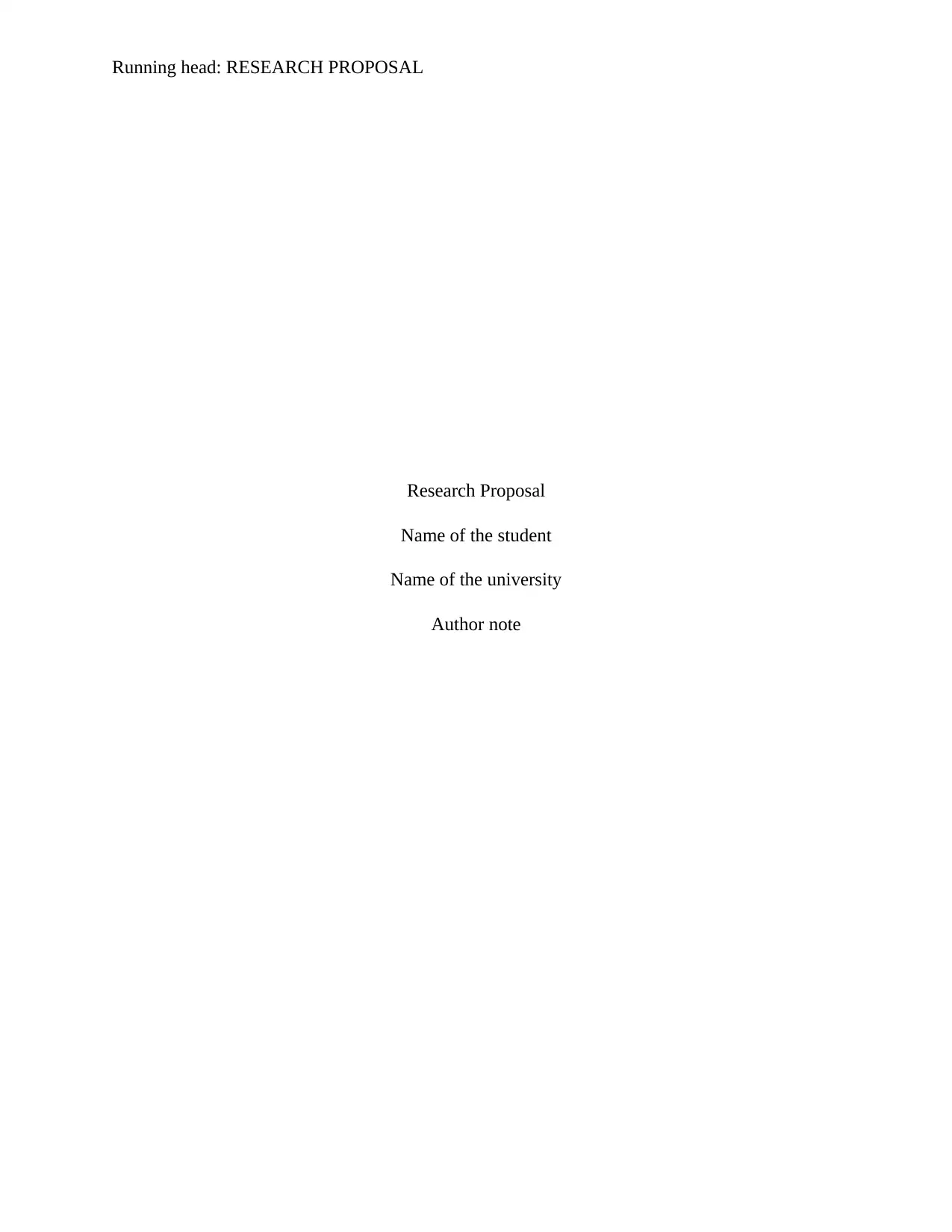
Running head: RESEARCH PROPOSAL
Research Proposal
Name of the student
Name of the university
Author note
Research Proposal
Name of the student
Name of the university
Author note
Paraphrase This Document
Need a fresh take? Get an instant paraphrase of this document with our AI Paraphraser
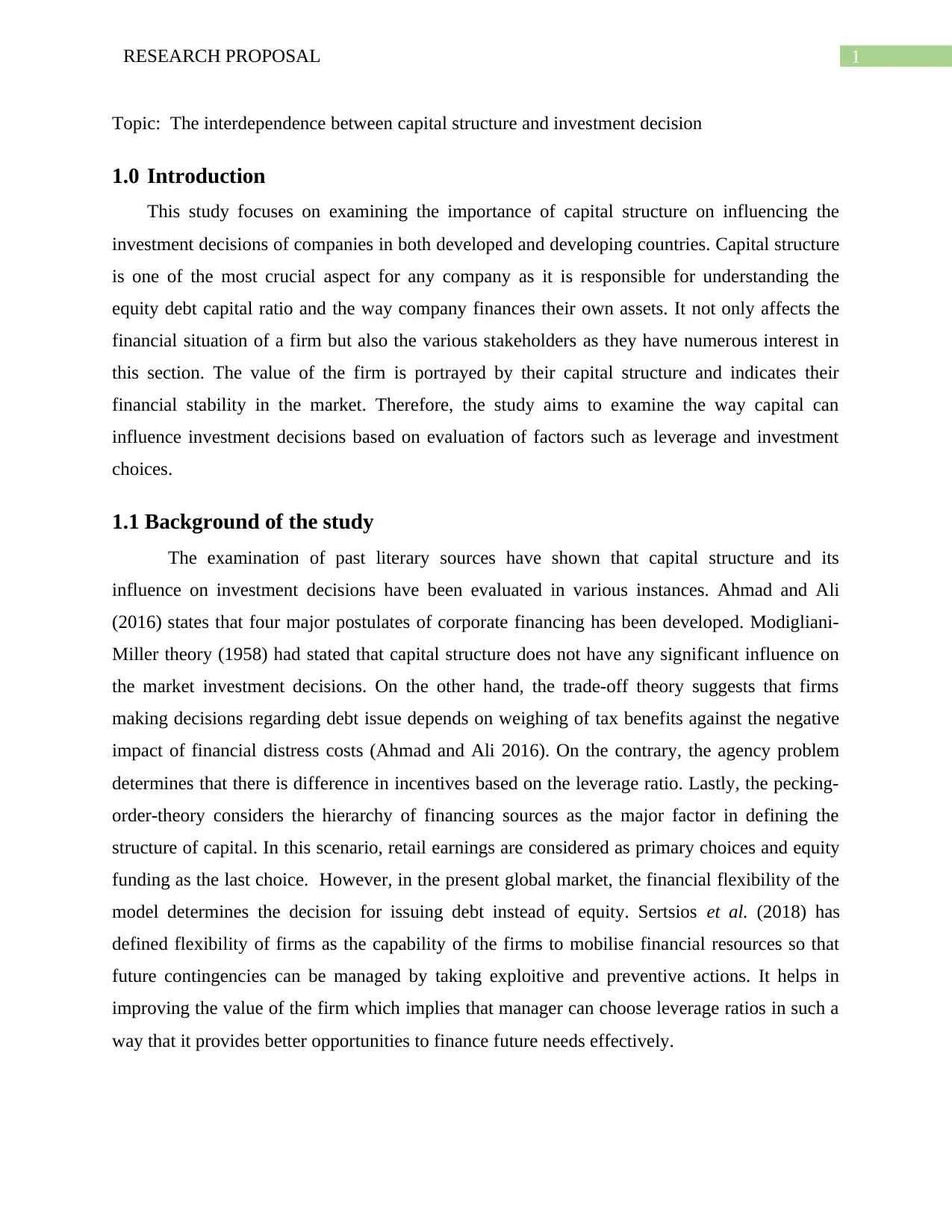
1RESEARCH PROPOSAL
Topic: The interdependence between capital structure and investment decision
1.0 Introduction
This study focuses on examining the importance of capital structure on influencing the
investment decisions of companies in both developed and developing countries. Capital structure
is one of the most crucial aspect for any company as it is responsible for understanding the
equity debt capital ratio and the way company finances their own assets. It not only affects the
financial situation of a firm but also the various stakeholders as they have numerous interest in
this section. The value of the firm is portrayed by their capital structure and indicates their
financial stability in the market. Therefore, the study aims to examine the way capital can
influence investment decisions based on evaluation of factors such as leverage and investment
choices.
1.1 Background of the study
The examination of past literary sources have shown that capital structure and its
influence on investment decisions have been evaluated in various instances. Ahmad and Ali
(2016) states that four major postulates of corporate financing has been developed. Modigliani-
Miller theory (1958) had stated that capital structure does not have any significant influence on
the market investment decisions. On the other hand, the trade-off theory suggests that firms
making decisions regarding debt issue depends on weighing of tax benefits against the negative
impact of financial distress costs (Ahmad and Ali 2016). On the contrary, the agency problem
determines that there is difference in incentives based on the leverage ratio. Lastly, the pecking-
order-theory considers the hierarchy of financing sources as the major factor in defining the
structure of capital. In this scenario, retail earnings are considered as primary choices and equity
funding as the last choice. However, in the present global market, the financial flexibility of the
model determines the decision for issuing debt instead of equity. Sertsios et al. (2018) has
defined flexibility of firms as the capability of the firms to mobilise financial resources so that
future contingencies can be managed by taking exploitive and preventive actions. It helps in
improving the value of the firm which implies that manager can choose leverage ratios in such a
way that it provides better opportunities to finance future needs effectively.
Topic: The interdependence between capital structure and investment decision
1.0 Introduction
This study focuses on examining the importance of capital structure on influencing the
investment decisions of companies in both developed and developing countries. Capital structure
is one of the most crucial aspect for any company as it is responsible for understanding the
equity debt capital ratio and the way company finances their own assets. It not only affects the
financial situation of a firm but also the various stakeholders as they have numerous interest in
this section. The value of the firm is portrayed by their capital structure and indicates their
financial stability in the market. Therefore, the study aims to examine the way capital can
influence investment decisions based on evaluation of factors such as leverage and investment
choices.
1.1 Background of the study
The examination of past literary sources have shown that capital structure and its
influence on investment decisions have been evaluated in various instances. Ahmad and Ali
(2016) states that four major postulates of corporate financing has been developed. Modigliani-
Miller theory (1958) had stated that capital structure does not have any significant influence on
the market investment decisions. On the other hand, the trade-off theory suggests that firms
making decisions regarding debt issue depends on weighing of tax benefits against the negative
impact of financial distress costs (Ahmad and Ali 2016). On the contrary, the agency problem
determines that there is difference in incentives based on the leverage ratio. Lastly, the pecking-
order-theory considers the hierarchy of financing sources as the major factor in defining the
structure of capital. In this scenario, retail earnings are considered as primary choices and equity
funding as the last choice. However, in the present global market, the financial flexibility of the
model determines the decision for issuing debt instead of equity. Sertsios et al. (2018) has
defined flexibility of firms as the capability of the firms to mobilise financial resources so that
future contingencies can be managed by taking exploitive and preventive actions. It helps in
improving the value of the firm which implies that manager can choose leverage ratios in such a
way that it provides better opportunities to finance future needs effectively.
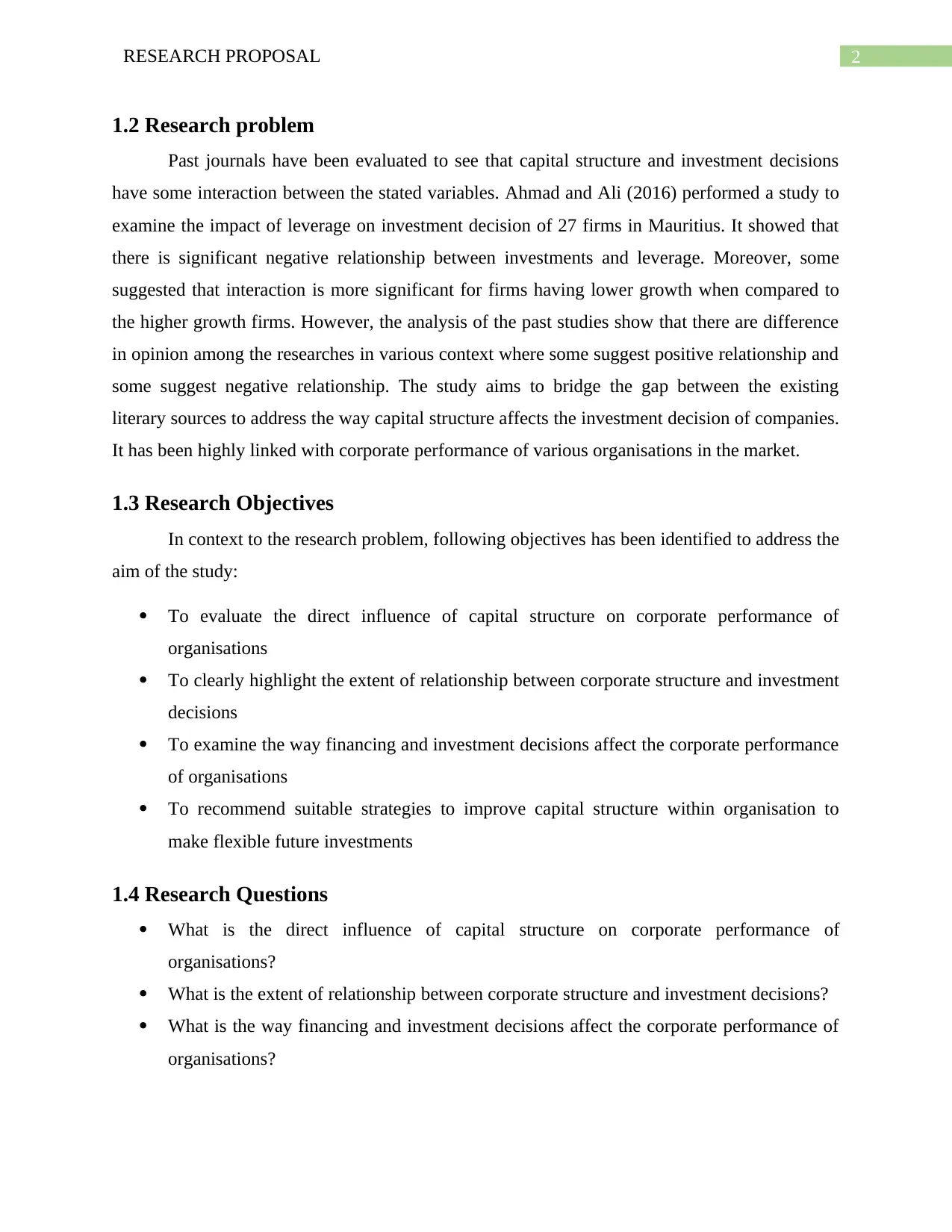
2RESEARCH PROPOSAL
1.2 Research problem
Past journals have been evaluated to see that capital structure and investment decisions
have some interaction between the stated variables. Ahmad and Ali (2016) performed a study to
examine the impact of leverage on investment decision of 27 firms in Mauritius. It showed that
there is significant negative relationship between investments and leverage. Moreover, some
suggested that interaction is more significant for firms having lower growth when compared to
the higher growth firms. However, the analysis of the past studies show that there are difference
in opinion among the researches in various context where some suggest positive relationship and
some suggest negative relationship. The study aims to bridge the gap between the existing
literary sources to address the way capital structure affects the investment decision of companies.
It has been highly linked with corporate performance of various organisations in the market.
1.3 Research Objectives
In context to the research problem, following objectives has been identified to address the
aim of the study:
To evaluate the direct influence of capital structure on corporate performance of
organisations
To clearly highlight the extent of relationship between corporate structure and investment
decisions
To examine the way financing and investment decisions affect the corporate performance
of organisations
To recommend suitable strategies to improve capital structure within organisation to
make flexible future investments
1.4 Research Questions
What is the direct influence of capital structure on corporate performance of
organisations?
What is the extent of relationship between corporate structure and investment decisions?
What is the way financing and investment decisions affect the corporate performance of
organisations?
1.2 Research problem
Past journals have been evaluated to see that capital structure and investment decisions
have some interaction between the stated variables. Ahmad and Ali (2016) performed a study to
examine the impact of leverage on investment decision of 27 firms in Mauritius. It showed that
there is significant negative relationship between investments and leverage. Moreover, some
suggested that interaction is more significant for firms having lower growth when compared to
the higher growth firms. However, the analysis of the past studies show that there are difference
in opinion among the researches in various context where some suggest positive relationship and
some suggest negative relationship. The study aims to bridge the gap between the existing
literary sources to address the way capital structure affects the investment decision of companies.
It has been highly linked with corporate performance of various organisations in the market.
1.3 Research Objectives
In context to the research problem, following objectives has been identified to address the
aim of the study:
To evaluate the direct influence of capital structure on corporate performance of
organisations
To clearly highlight the extent of relationship between corporate structure and investment
decisions
To examine the way financing and investment decisions affect the corporate performance
of organisations
To recommend suitable strategies to improve capital structure within organisation to
make flexible future investments
1.4 Research Questions
What is the direct influence of capital structure on corporate performance of
organisations?
What is the extent of relationship between corporate structure and investment decisions?
What is the way financing and investment decisions affect the corporate performance of
organisations?
⊘ This is a preview!⊘
Do you want full access?
Subscribe today to unlock all pages.

Trusted by 1+ million students worldwide
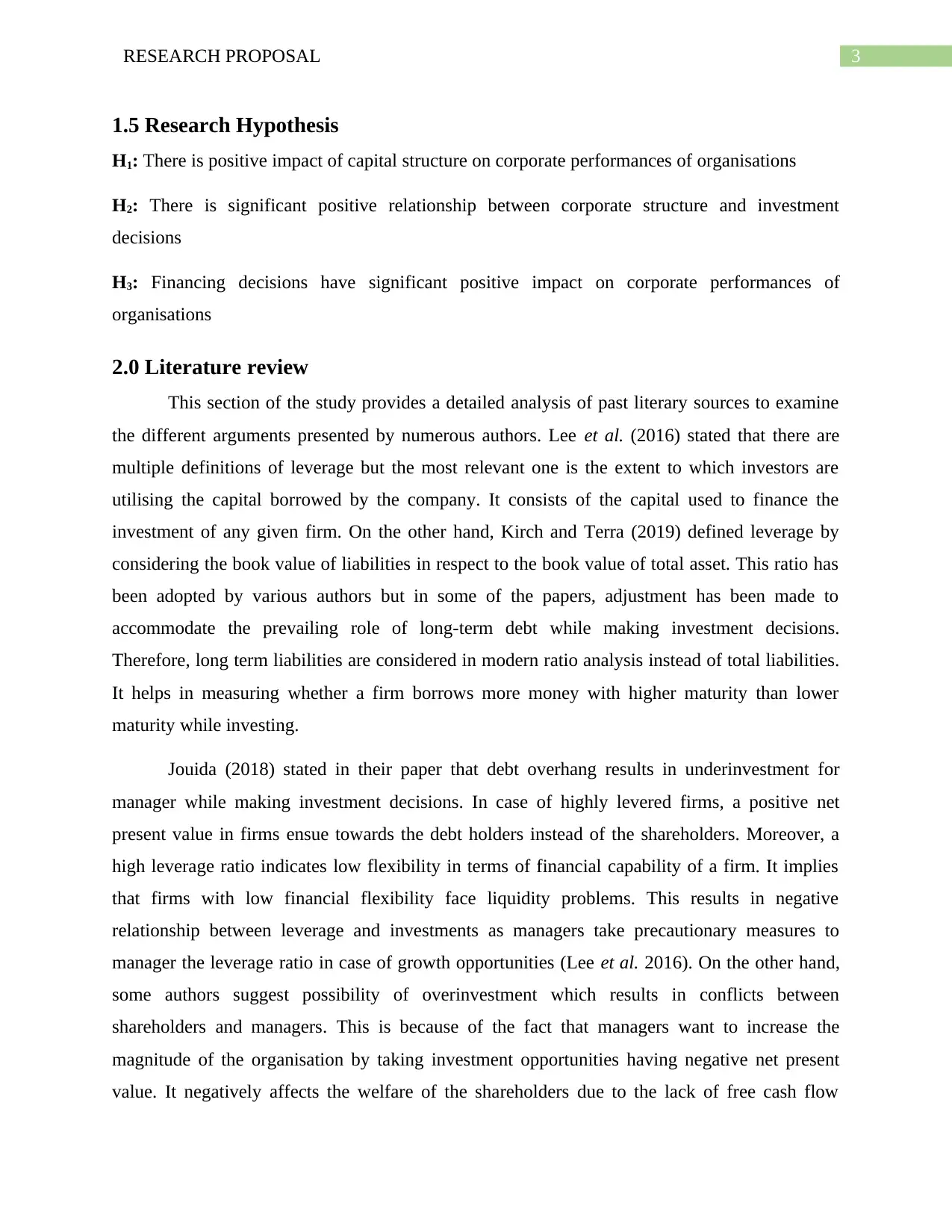
3RESEARCH PROPOSAL
1.5 Research Hypothesis
H1: There is positive impact of capital structure on corporate performances of organisations
H2: There is significant positive relationship between corporate structure and investment
decisions
H3: Financing decisions have significant positive impact on corporate performances of
organisations
2.0 Literature review
This section of the study provides a detailed analysis of past literary sources to examine
the different arguments presented by numerous authors. Lee et al. (2016) stated that there are
multiple definitions of leverage but the most relevant one is the extent to which investors are
utilising the capital borrowed by the company. It consists of the capital used to finance the
investment of any given firm. On the other hand, Kirch and Terra (2019) defined leverage by
considering the book value of liabilities in respect to the book value of total asset. This ratio has
been adopted by various authors but in some of the papers, adjustment has been made to
accommodate the prevailing role of long-term debt while making investment decisions.
Therefore, long term liabilities are considered in modern ratio analysis instead of total liabilities.
It helps in measuring whether a firm borrows more money with higher maturity than lower
maturity while investing.
Jouida (2018) stated in their paper that debt overhang results in underinvestment for
manager while making investment decisions. In case of highly levered firms, a positive net
present value in firms ensue towards the debt holders instead of the shareholders. Moreover, a
high leverage ratio indicates low flexibility in terms of financial capability of a firm. It implies
that firms with low financial flexibility face liquidity problems. This results in negative
relationship between leverage and investments as managers take precautionary measures to
manager the leverage ratio in case of growth opportunities (Lee et al. 2016). On the other hand,
some authors suggest possibility of overinvestment which results in conflicts between
shareholders and managers. This is because of the fact that managers want to increase the
magnitude of the organisation by taking investment opportunities having negative net present
value. It negatively affects the welfare of the shareholders due to the lack of free cash flow
1.5 Research Hypothesis
H1: There is positive impact of capital structure on corporate performances of organisations
H2: There is significant positive relationship between corporate structure and investment
decisions
H3: Financing decisions have significant positive impact on corporate performances of
organisations
2.0 Literature review
This section of the study provides a detailed analysis of past literary sources to examine
the different arguments presented by numerous authors. Lee et al. (2016) stated that there are
multiple definitions of leverage but the most relevant one is the extent to which investors are
utilising the capital borrowed by the company. It consists of the capital used to finance the
investment of any given firm. On the other hand, Kirch and Terra (2019) defined leverage by
considering the book value of liabilities in respect to the book value of total asset. This ratio has
been adopted by various authors but in some of the papers, adjustment has been made to
accommodate the prevailing role of long-term debt while making investment decisions.
Therefore, long term liabilities are considered in modern ratio analysis instead of total liabilities.
It helps in measuring whether a firm borrows more money with higher maturity than lower
maturity while investing.
Jouida (2018) stated in their paper that debt overhang results in underinvestment for
manager while making investment decisions. In case of highly levered firms, a positive net
present value in firms ensue towards the debt holders instead of the shareholders. Moreover, a
high leverage ratio indicates low flexibility in terms of financial capability of a firm. It implies
that firms with low financial flexibility face liquidity problems. This results in negative
relationship between leverage and investments as managers take precautionary measures to
manager the leverage ratio in case of growth opportunities (Lee et al. 2016). On the other hand,
some authors suggest possibility of overinvestment which results in conflicts between
shareholders and managers. This is because of the fact that managers want to increase the
magnitude of the organisation by taking investment opportunities having negative net present
value. It negatively affects the welfare of the shareholders due to the lack of free cash flow
Paraphrase This Document
Need a fresh take? Get an instant paraphrase of this document with our AI Paraphraser
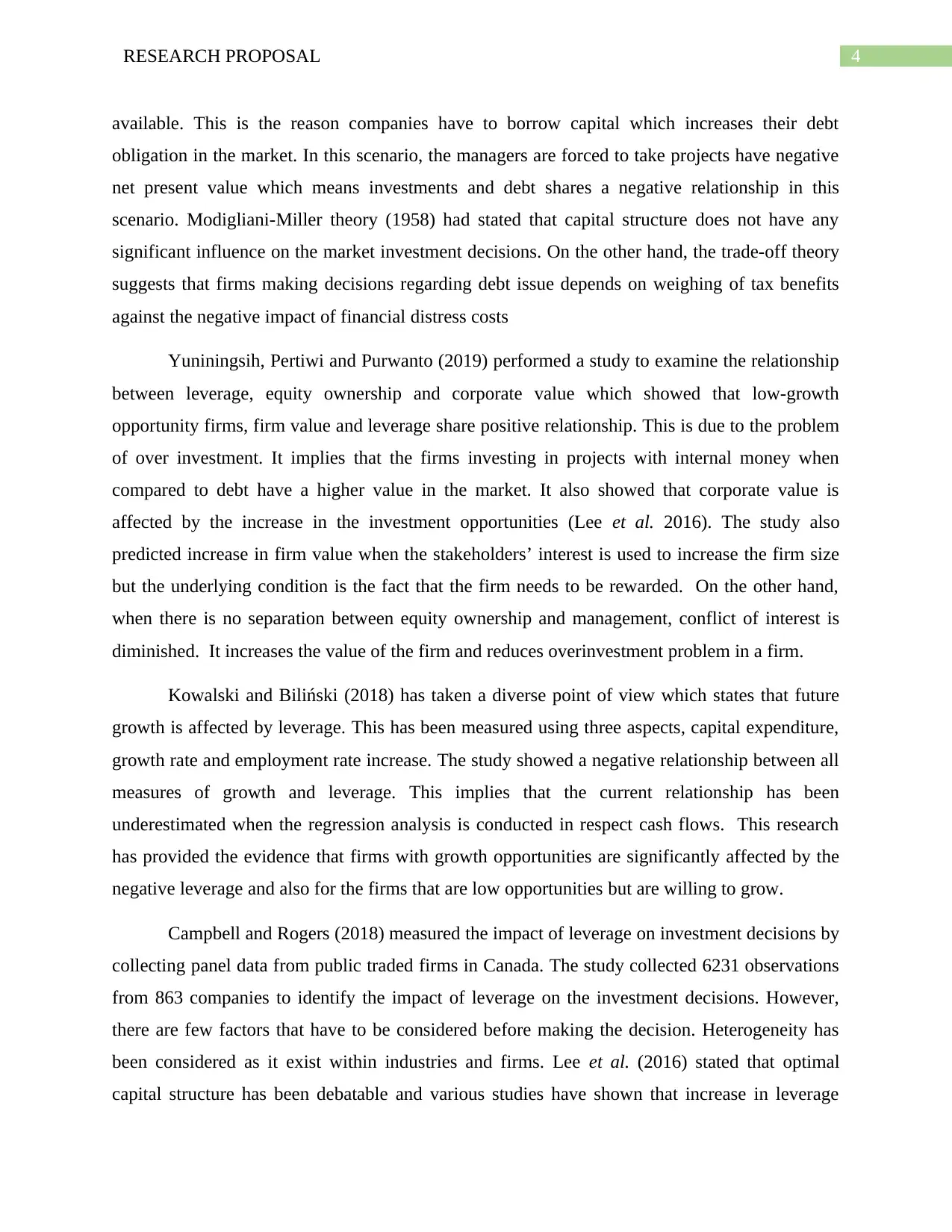
4RESEARCH PROPOSAL
available. This is the reason companies have to borrow capital which increases their debt
obligation in the market. In this scenario, the managers are forced to take projects have negative
net present value which means investments and debt shares a negative relationship in this
scenario. Modigliani-Miller theory (1958) had stated that capital structure does not have any
significant influence on the market investment decisions. On the other hand, the trade-off theory
suggests that firms making decisions regarding debt issue depends on weighing of tax benefits
against the negative impact of financial distress costs
Yuniningsih, Pertiwi and Purwanto (2019) performed a study to examine the relationship
between leverage, equity ownership and corporate value which showed that low-growth
opportunity firms, firm value and leverage share positive relationship. This is due to the problem
of over investment. It implies that the firms investing in projects with internal money when
compared to debt have a higher value in the market. It also showed that corporate value is
affected by the increase in the investment opportunities (Lee et al. 2016). The study also
predicted increase in firm value when the stakeholders’ interest is used to increase the firm size
but the underlying condition is the fact that the firm needs to be rewarded. On the other hand,
when there is no separation between equity ownership and management, conflict of interest is
diminished. It increases the value of the firm and reduces overinvestment problem in a firm.
Kowalski and Biliński (2018) has taken a diverse point of view which states that future
growth is affected by leverage. This has been measured using three aspects, capital expenditure,
growth rate and employment rate increase. The study showed a negative relationship between all
measures of growth and leverage. This implies that the current relationship has been
underestimated when the regression analysis is conducted in respect cash flows. This research
has provided the evidence that firms with growth opportunities are significantly affected by the
negative leverage and also for the firms that are low opportunities but are willing to grow.
Campbell and Rogers (2018) measured the impact of leverage on investment decisions by
collecting panel data from public traded firms in Canada. The study collected 6231 observations
from 863 companies to identify the impact of leverage on the investment decisions. However,
there are few factors that have to be considered before making the decision. Heterogeneity has
been considered as it exist within industries and firms. Lee et al. (2016) stated that optimal
capital structure has been debatable and various studies have shown that increase in leverage
available. This is the reason companies have to borrow capital which increases their debt
obligation in the market. In this scenario, the managers are forced to take projects have negative
net present value which means investments and debt shares a negative relationship in this
scenario. Modigliani-Miller theory (1958) had stated that capital structure does not have any
significant influence on the market investment decisions. On the other hand, the trade-off theory
suggests that firms making decisions regarding debt issue depends on weighing of tax benefits
against the negative impact of financial distress costs
Yuniningsih, Pertiwi and Purwanto (2019) performed a study to examine the relationship
between leverage, equity ownership and corporate value which showed that low-growth
opportunity firms, firm value and leverage share positive relationship. This is due to the problem
of over investment. It implies that the firms investing in projects with internal money when
compared to debt have a higher value in the market. It also showed that corporate value is
affected by the increase in the investment opportunities (Lee et al. 2016). The study also
predicted increase in firm value when the stakeholders’ interest is used to increase the firm size
but the underlying condition is the fact that the firm needs to be rewarded. On the other hand,
when there is no separation between equity ownership and management, conflict of interest is
diminished. It increases the value of the firm and reduces overinvestment problem in a firm.
Kowalski and Biliński (2018) has taken a diverse point of view which states that future
growth is affected by leverage. This has been measured using three aspects, capital expenditure,
growth rate and employment rate increase. The study showed a negative relationship between all
measures of growth and leverage. This implies that the current relationship has been
underestimated when the regression analysis is conducted in respect cash flows. This research
has provided the evidence that firms with growth opportunities are significantly affected by the
negative leverage and also for the firms that are low opportunities but are willing to grow.
Campbell and Rogers (2018) measured the impact of leverage on investment decisions by
collecting panel data from public traded firms in Canada. The study collected 6231 observations
from 863 companies to identify the impact of leverage on the investment decisions. However,
there are few factors that have to be considered before making the decision. Heterogeneity has
been considered as it exist within industries and firms. Lee et al. (2016) stated that optimal
capital structure has been debatable and various studies have shown that increase in leverage
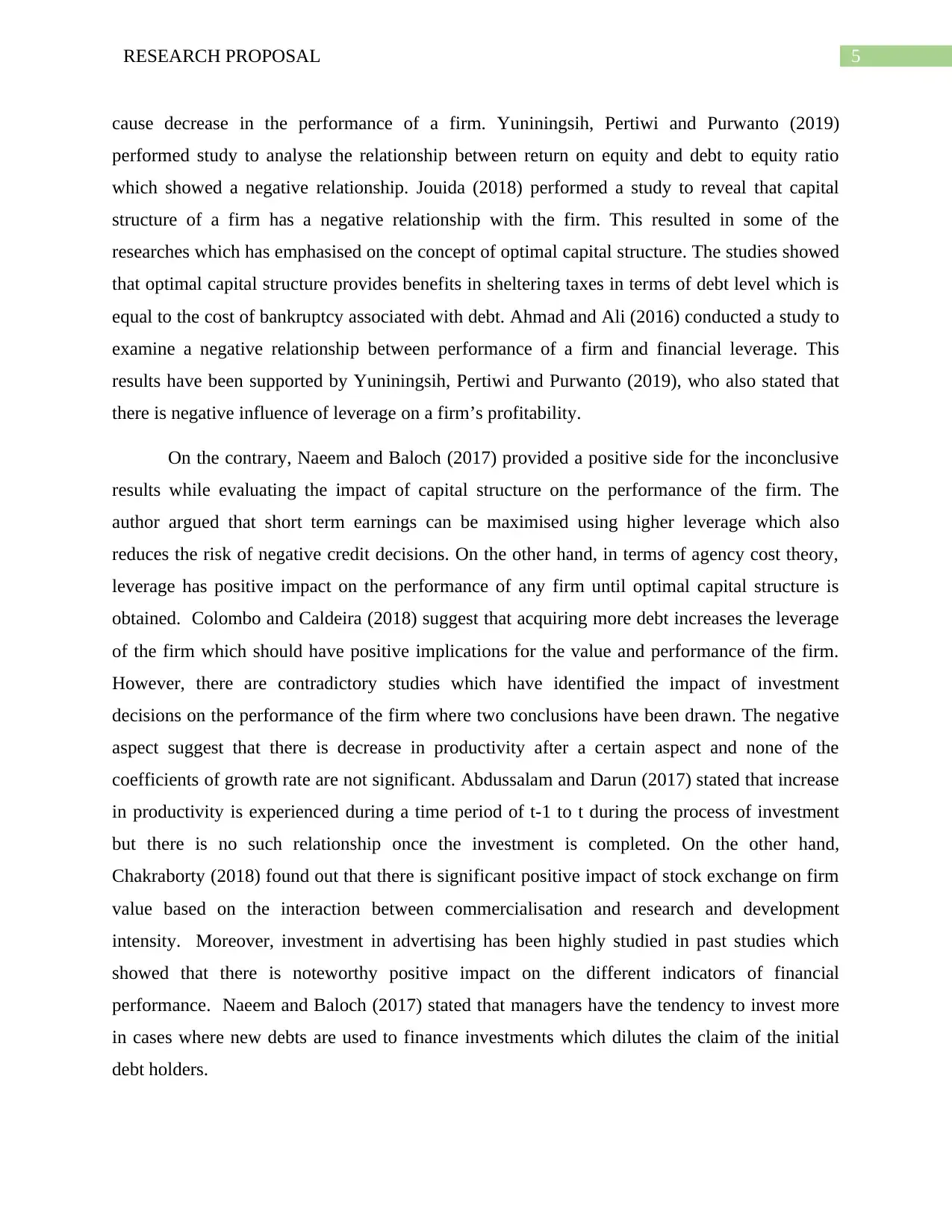
5RESEARCH PROPOSAL
cause decrease in the performance of a firm. Yuniningsih, Pertiwi and Purwanto (2019)
performed study to analyse the relationship between return on equity and debt to equity ratio
which showed a negative relationship. Jouida (2018) performed a study to reveal that capital
structure of a firm has a negative relationship with the firm. This resulted in some of the
researches which has emphasised on the concept of optimal capital structure. The studies showed
that optimal capital structure provides benefits in sheltering taxes in terms of debt level which is
equal to the cost of bankruptcy associated with debt. Ahmad and Ali (2016) conducted a study to
examine a negative relationship between performance of a firm and financial leverage. This
results have been supported by Yuniningsih, Pertiwi and Purwanto (2019), who also stated that
there is negative influence of leverage on a firm’s profitability.
On the contrary, Naeem and Baloch (2017) provided a positive side for the inconclusive
results while evaluating the impact of capital structure on the performance of the firm. The
author argued that short term earnings can be maximised using higher leverage which also
reduces the risk of negative credit decisions. On the other hand, in terms of agency cost theory,
leverage has positive impact on the performance of any firm until optimal capital structure is
obtained. Colombo and Caldeira (2018) suggest that acquiring more debt increases the leverage
of the firm which should have positive implications for the value and performance of the firm.
However, there are contradictory studies which have identified the impact of investment
decisions on the performance of the firm where two conclusions have been drawn. The negative
aspect suggest that there is decrease in productivity after a certain aspect and none of the
coefficients of growth rate are not significant. Abdussalam and Darun (2017) stated that increase
in productivity is experienced during a time period of t-1 to t during the process of investment
but there is no such relationship once the investment is completed. On the other hand,
Chakraborty (2018) found out that there is significant positive impact of stock exchange on firm
value based on the interaction between commercialisation and research and development
intensity. Moreover, investment in advertising has been highly studied in past studies which
showed that there is noteworthy positive impact on the different indicators of financial
performance. Naeem and Baloch (2017) stated that managers have the tendency to invest more
in cases where new debts are used to finance investments which dilutes the claim of the initial
debt holders.
cause decrease in the performance of a firm. Yuniningsih, Pertiwi and Purwanto (2019)
performed study to analyse the relationship between return on equity and debt to equity ratio
which showed a negative relationship. Jouida (2018) performed a study to reveal that capital
structure of a firm has a negative relationship with the firm. This resulted in some of the
researches which has emphasised on the concept of optimal capital structure. The studies showed
that optimal capital structure provides benefits in sheltering taxes in terms of debt level which is
equal to the cost of bankruptcy associated with debt. Ahmad and Ali (2016) conducted a study to
examine a negative relationship between performance of a firm and financial leverage. This
results have been supported by Yuniningsih, Pertiwi and Purwanto (2019), who also stated that
there is negative influence of leverage on a firm’s profitability.
On the contrary, Naeem and Baloch (2017) provided a positive side for the inconclusive
results while evaluating the impact of capital structure on the performance of the firm. The
author argued that short term earnings can be maximised using higher leverage which also
reduces the risk of negative credit decisions. On the other hand, in terms of agency cost theory,
leverage has positive impact on the performance of any firm until optimal capital structure is
obtained. Colombo and Caldeira (2018) suggest that acquiring more debt increases the leverage
of the firm which should have positive implications for the value and performance of the firm.
However, there are contradictory studies which have identified the impact of investment
decisions on the performance of the firm where two conclusions have been drawn. The negative
aspect suggest that there is decrease in productivity after a certain aspect and none of the
coefficients of growth rate are not significant. Abdussalam and Darun (2017) stated that increase
in productivity is experienced during a time period of t-1 to t during the process of investment
but there is no such relationship once the investment is completed. On the other hand,
Chakraborty (2018) found out that there is significant positive impact of stock exchange on firm
value based on the interaction between commercialisation and research and development
intensity. Moreover, investment in advertising has been highly studied in past studies which
showed that there is noteworthy positive impact on the different indicators of financial
performance. Naeem and Baloch (2017) stated that managers have the tendency to invest more
in cases where new debts are used to finance investments which dilutes the claim of the initial
debt holders.
⊘ This is a preview!⊘
Do you want full access?
Subscribe today to unlock all pages.

Trusted by 1+ million students worldwide
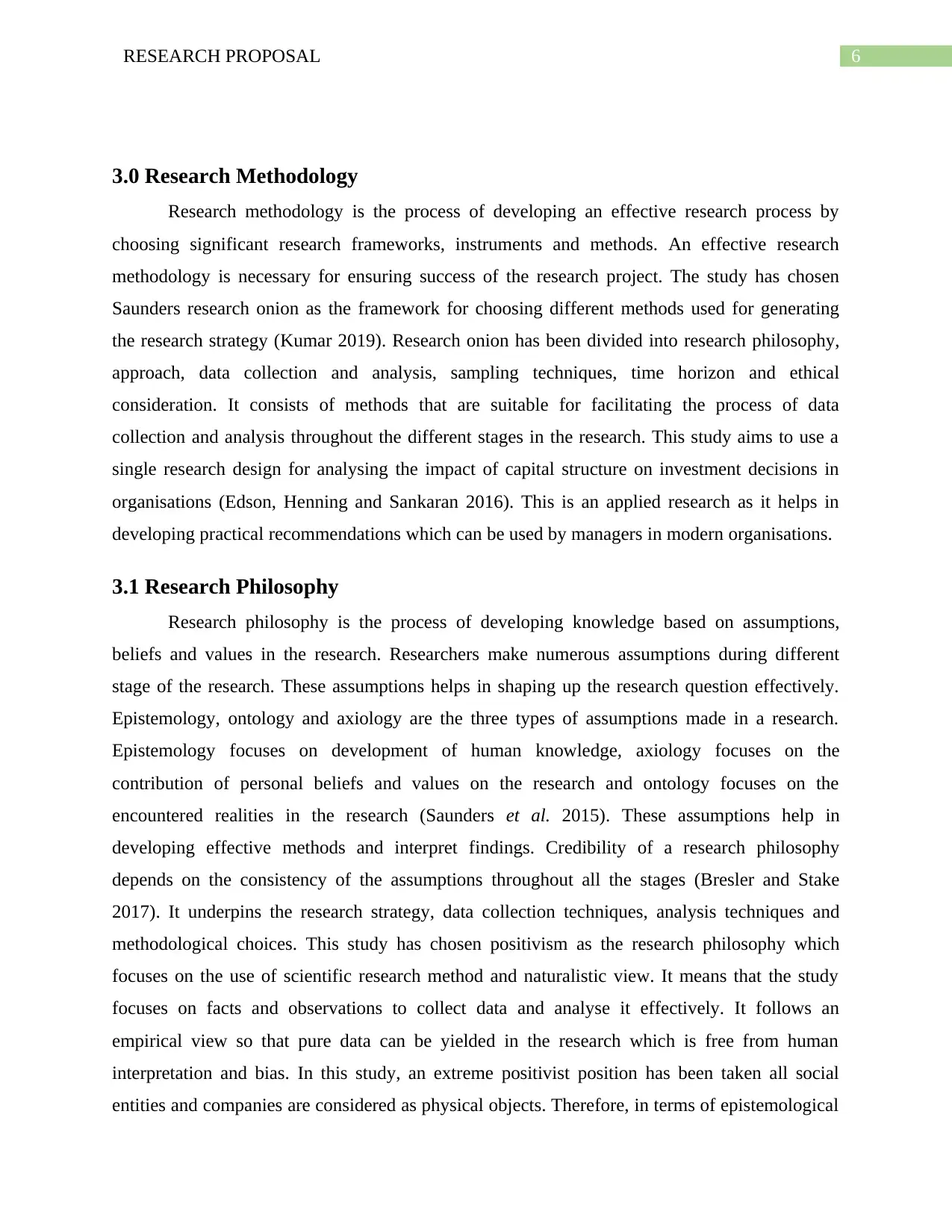
6RESEARCH PROPOSAL
3.0 Research Methodology
Research methodology is the process of developing an effective research process by
choosing significant research frameworks, instruments and methods. An effective research
methodology is necessary for ensuring success of the research project. The study has chosen
Saunders research onion as the framework for choosing different methods used for generating
the research strategy (Kumar 2019). Research onion has been divided into research philosophy,
approach, data collection and analysis, sampling techniques, time horizon and ethical
consideration. It consists of methods that are suitable for facilitating the process of data
collection and analysis throughout the different stages in the research. This study aims to use a
single research design for analysing the impact of capital structure on investment decisions in
organisations (Edson, Henning and Sankaran 2016). This is an applied research as it helps in
developing practical recommendations which can be used by managers in modern organisations.
3.1 Research Philosophy
Research philosophy is the process of developing knowledge based on assumptions,
beliefs and values in the research. Researchers make numerous assumptions during different
stage of the research. These assumptions helps in shaping up the research question effectively.
Epistemology, ontology and axiology are the three types of assumptions made in a research.
Epistemology focuses on development of human knowledge, axiology focuses on the
contribution of personal beliefs and values on the research and ontology focuses on the
encountered realities in the research (Saunders et al. 2015). These assumptions help in
developing effective methods and interpret findings. Credibility of a research philosophy
depends on the consistency of the assumptions throughout all the stages (Bresler and Stake
2017). It underpins the research strategy, data collection techniques, analysis techniques and
methodological choices. This study has chosen positivism as the research philosophy which
focuses on the use of scientific research method and naturalistic view. It means that the study
focuses on facts and observations to collect data and analyse it effectively. It follows an
empirical view so that pure data can be yielded in the research which is free from human
interpretation and bias. In this study, an extreme positivist position has been taken all social
entities and companies are considered as physical objects. Therefore, in terms of epistemological
3.0 Research Methodology
Research methodology is the process of developing an effective research process by
choosing significant research frameworks, instruments and methods. An effective research
methodology is necessary for ensuring success of the research project. The study has chosen
Saunders research onion as the framework for choosing different methods used for generating
the research strategy (Kumar 2019). Research onion has been divided into research philosophy,
approach, data collection and analysis, sampling techniques, time horizon and ethical
consideration. It consists of methods that are suitable for facilitating the process of data
collection and analysis throughout the different stages in the research. This study aims to use a
single research design for analysing the impact of capital structure on investment decisions in
organisations (Edson, Henning and Sankaran 2016). This is an applied research as it helps in
developing practical recommendations which can be used by managers in modern organisations.
3.1 Research Philosophy
Research philosophy is the process of developing knowledge based on assumptions,
beliefs and values in the research. Researchers make numerous assumptions during different
stage of the research. These assumptions helps in shaping up the research question effectively.
Epistemology, ontology and axiology are the three types of assumptions made in a research.
Epistemology focuses on development of human knowledge, axiology focuses on the
contribution of personal beliefs and values on the research and ontology focuses on the
encountered realities in the research (Saunders et al. 2015). These assumptions help in
developing effective methods and interpret findings. Credibility of a research philosophy
depends on the consistency of the assumptions throughout all the stages (Bresler and Stake
2017). It underpins the research strategy, data collection techniques, analysis techniques and
methodological choices. This study has chosen positivism as the research philosophy which
focuses on the use of scientific research method and naturalistic view. It means that the study
focuses on facts and observations to collect data and analyse it effectively. It follows an
empirical view so that pure data can be yielded in the research which is free from human
interpretation and bias. In this study, an extreme positivist position has been taken all social
entities and companies are considered as physical objects. Therefore, in terms of epistemological
Paraphrase This Document
Need a fresh take? Get an instant paraphrase of this document with our AI Paraphraser
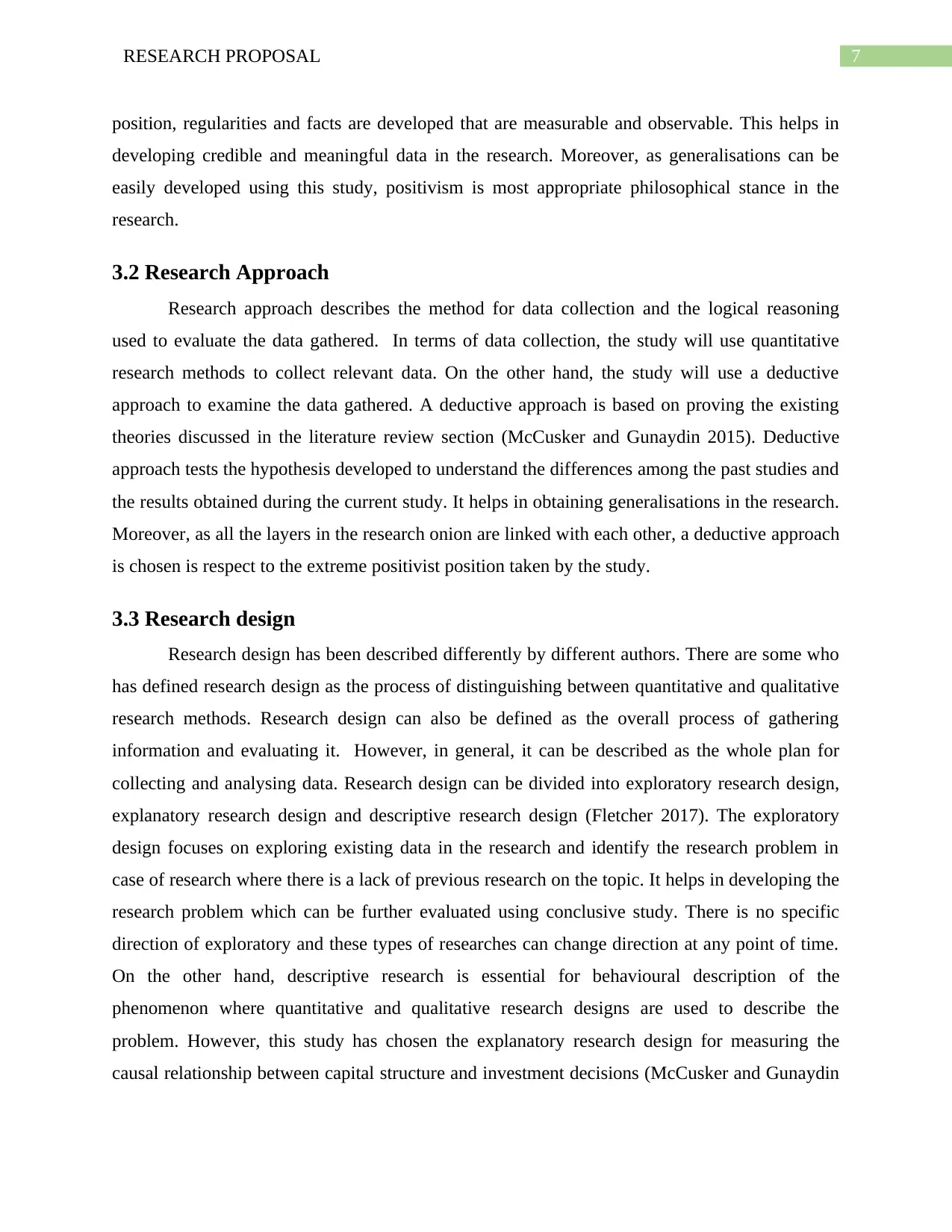
7RESEARCH PROPOSAL
position, regularities and facts are developed that are measurable and observable. This helps in
developing credible and meaningful data in the research. Moreover, as generalisations can be
easily developed using this study, positivism is most appropriate philosophical stance in the
research.
3.2 Research Approach
Research approach describes the method for data collection and the logical reasoning
used to evaluate the data gathered. In terms of data collection, the study will use quantitative
research methods to collect relevant data. On the other hand, the study will use a deductive
approach to examine the data gathered. A deductive approach is based on proving the existing
theories discussed in the literature review section (McCusker and Gunaydin 2015). Deductive
approach tests the hypothesis developed to understand the differences among the past studies and
the results obtained during the current study. It helps in obtaining generalisations in the research.
Moreover, as all the layers in the research onion are linked with each other, a deductive approach
is chosen is respect to the extreme positivist position taken by the study.
3.3 Research design
Research design has been described differently by different authors. There are some who
has defined research design as the process of distinguishing between quantitative and qualitative
research methods. Research design can also be defined as the overall process of gathering
information and evaluating it. However, in general, it can be described as the whole plan for
collecting and analysing data. Research design can be divided into exploratory research design,
explanatory research design and descriptive research design (Fletcher 2017). The exploratory
design focuses on exploring existing data in the research and identify the research problem in
case of research where there is a lack of previous research on the topic. It helps in developing the
research problem which can be further evaluated using conclusive study. There is no specific
direction of exploratory and these types of researches can change direction at any point of time.
On the other hand, descriptive research is essential for behavioural description of the
phenomenon where quantitative and qualitative research designs are used to describe the
problem. However, this study has chosen the explanatory research design for measuring the
causal relationship between capital structure and investment decisions (McCusker and Gunaydin
position, regularities and facts are developed that are measurable and observable. This helps in
developing credible and meaningful data in the research. Moreover, as generalisations can be
easily developed using this study, positivism is most appropriate philosophical stance in the
research.
3.2 Research Approach
Research approach describes the method for data collection and the logical reasoning
used to evaluate the data gathered. In terms of data collection, the study will use quantitative
research methods to collect relevant data. On the other hand, the study will use a deductive
approach to examine the data gathered. A deductive approach is based on proving the existing
theories discussed in the literature review section (McCusker and Gunaydin 2015). Deductive
approach tests the hypothesis developed to understand the differences among the past studies and
the results obtained during the current study. It helps in obtaining generalisations in the research.
Moreover, as all the layers in the research onion are linked with each other, a deductive approach
is chosen is respect to the extreme positivist position taken by the study.
3.3 Research design
Research design has been described differently by different authors. There are some who
has defined research design as the process of distinguishing between quantitative and qualitative
research methods. Research design can also be defined as the overall process of gathering
information and evaluating it. However, in general, it can be described as the whole plan for
collecting and analysing data. Research design can be divided into exploratory research design,
explanatory research design and descriptive research design (Fletcher 2017). The exploratory
design focuses on exploring existing data in the research and identify the research problem in
case of research where there is a lack of previous research on the topic. It helps in developing the
research problem which can be further evaluated using conclusive study. There is no specific
direction of exploratory and these types of researches can change direction at any point of time.
On the other hand, descriptive research is essential for behavioural description of the
phenomenon where quantitative and qualitative research designs are used to describe the
problem. However, this study has chosen the explanatory research design for measuring the
causal relationship between capital structure and investment decisions (McCusker and Gunaydin

8RESEARCH PROPOSAL
2015). The explanatory research design facilitates in testing the hypothesis mentioned in the
introduction chapter of the research.
3.4 Data collection and analysis
The study has chosen primary data collection as the method for collecting data. In this
study, primary data will be collected using a survey questionnaire. The survey questionnaire will
be divided into three sections, the first section will address the demography of the participants,
the second section will consist of the questions on capital structure and the final section will
consist of questions on investment decisions (Humphries 2017). The study will use the four
measurement scales which will include ordinal, nominal, ratio and interval scale to develop the
questions. The demographic questions will be mainly developed on nominal and ordinal scale.
On the other hand, the questions on investment decisions and capital structure will be developed
on five point Likert scale. The survey questionnaire has been used as the research instrument in
the study. The survey questionnaire will consist of close ended questions so that desired results
can be obtained from the questions.
In case of data analysis, the study will use SPSS (statistical tool for social sciences) for
analysing the data collected. The research will use descriptive statistics and inferential statistics
to examine the impact of capital structure on investment decisions. Descriptive statistics will
consist of evaluating mean, median, mode, standard deviation, variance, skewness and Kurtosis.
It examines whether the data set collected follows a normal distribution or not. On the other
hand, the Pearson’s correlation will examine the nature and degree of association between
investment decisions and capital structure (McCusker and Gunaydin 2015). It helps in
understanding the relationship between all the variables chosen in the study. Regression analysis
has been used to develop a predictive model which helps in forecasting the change in
relationship. A linear model will be developed which establishes a straight line equation to
understand the association.
3.5 Sampling technique
Sampling is the process of choosing sample populace from the total population. It
facilitates in reducing the complexity, time and cost of the study. The first step of sampling is
choosing target population in the study and in this study, the target population will consist of the
2015). The explanatory research design facilitates in testing the hypothesis mentioned in the
introduction chapter of the research.
3.4 Data collection and analysis
The study has chosen primary data collection as the method for collecting data. In this
study, primary data will be collected using a survey questionnaire. The survey questionnaire will
be divided into three sections, the first section will address the demography of the participants,
the second section will consist of the questions on capital structure and the final section will
consist of questions on investment decisions (Humphries 2017). The study will use the four
measurement scales which will include ordinal, nominal, ratio and interval scale to develop the
questions. The demographic questions will be mainly developed on nominal and ordinal scale.
On the other hand, the questions on investment decisions and capital structure will be developed
on five point Likert scale. The survey questionnaire has been used as the research instrument in
the study. The survey questionnaire will consist of close ended questions so that desired results
can be obtained from the questions.
In case of data analysis, the study will use SPSS (statistical tool for social sciences) for
analysing the data collected. The research will use descriptive statistics and inferential statistics
to examine the impact of capital structure on investment decisions. Descriptive statistics will
consist of evaluating mean, median, mode, standard deviation, variance, skewness and Kurtosis.
It examines whether the data set collected follows a normal distribution or not. On the other
hand, the Pearson’s correlation will examine the nature and degree of association between
investment decisions and capital structure (McCusker and Gunaydin 2015). It helps in
understanding the relationship between all the variables chosen in the study. Regression analysis
has been used to develop a predictive model which helps in forecasting the change in
relationship. A linear model will be developed which establishes a straight line equation to
understand the association.
3.5 Sampling technique
Sampling is the process of choosing sample populace from the total population. It
facilitates in reducing the complexity, time and cost of the study. The first step of sampling is
choosing target population in the study and in this study, the target population will consist of the
⊘ This is a preview!⊘
Do you want full access?
Subscribe today to unlock all pages.

Trusted by 1+ million students worldwide
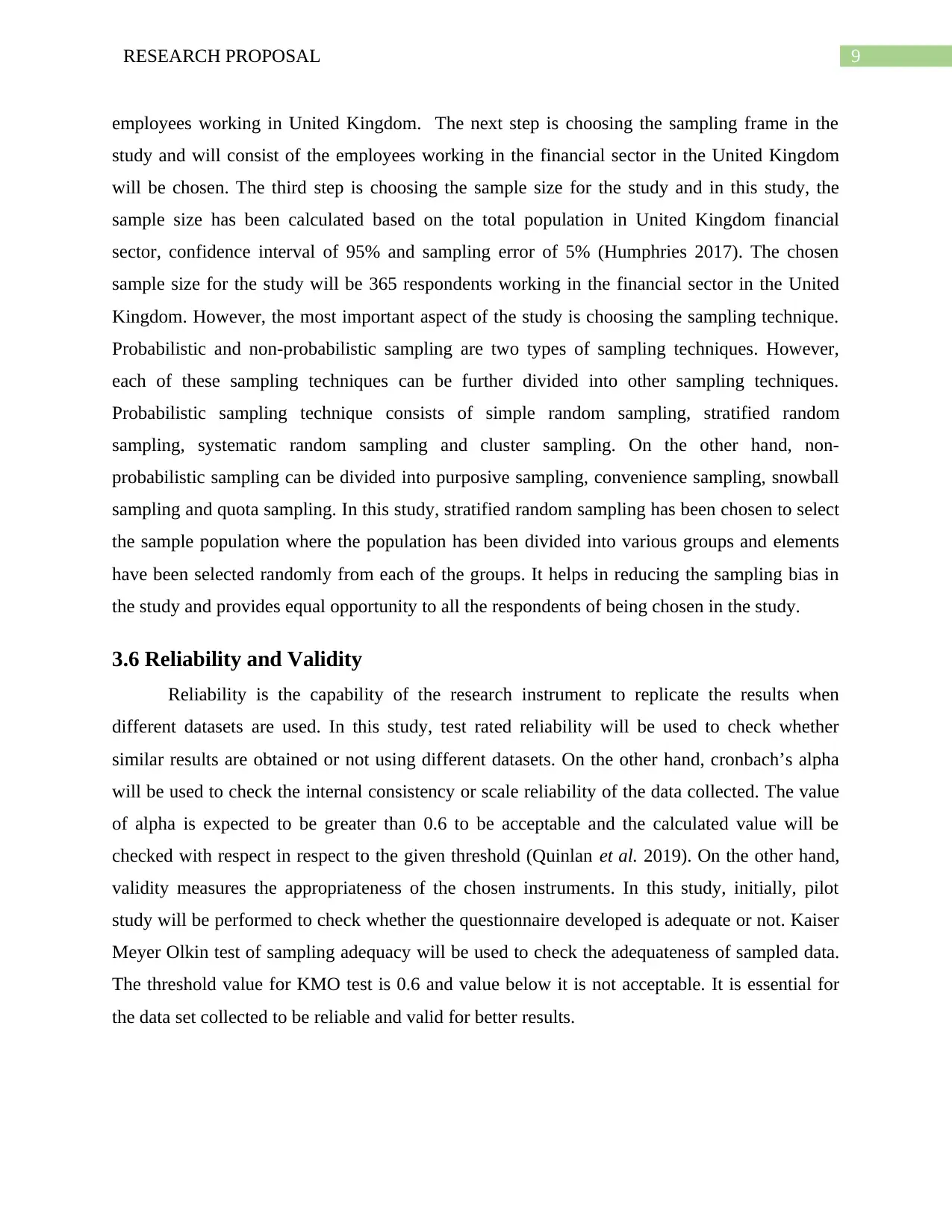
9RESEARCH PROPOSAL
employees working in United Kingdom. The next step is choosing the sampling frame in the
study and will consist of the employees working in the financial sector in the United Kingdom
will be chosen. The third step is choosing the sample size for the study and in this study, the
sample size has been calculated based on the total population in United Kingdom financial
sector, confidence interval of 95% and sampling error of 5% (Humphries 2017). The chosen
sample size for the study will be 365 respondents working in the financial sector in the United
Kingdom. However, the most important aspect of the study is choosing the sampling technique.
Probabilistic and non-probabilistic sampling are two types of sampling techniques. However,
each of these sampling techniques can be further divided into other sampling techniques.
Probabilistic sampling technique consists of simple random sampling, stratified random
sampling, systematic random sampling and cluster sampling. On the other hand, non-
probabilistic sampling can be divided into purposive sampling, convenience sampling, snowball
sampling and quota sampling. In this study, stratified random sampling has been chosen to select
the sample population where the population has been divided into various groups and elements
have been selected randomly from each of the groups. It helps in reducing the sampling bias in
the study and provides equal opportunity to all the respondents of being chosen in the study.
3.6 Reliability and Validity
Reliability is the capability of the research instrument to replicate the results when
different datasets are used. In this study, test rated reliability will be used to check whether
similar results are obtained or not using different datasets. On the other hand, cronbach’s alpha
will be used to check the internal consistency or scale reliability of the data collected. The value
of alpha is expected to be greater than 0.6 to be acceptable and the calculated value will be
checked with respect in respect to the given threshold (Quinlan et al. 2019). On the other hand,
validity measures the appropriateness of the chosen instruments. In this study, initially, pilot
study will be performed to check whether the questionnaire developed is adequate or not. Kaiser
Meyer Olkin test of sampling adequacy will be used to check the adequateness of sampled data.
The threshold value for KMO test is 0.6 and value below it is not acceptable. It is essential for
the data set collected to be reliable and valid for better results.
employees working in United Kingdom. The next step is choosing the sampling frame in the
study and will consist of the employees working in the financial sector in the United Kingdom
will be chosen. The third step is choosing the sample size for the study and in this study, the
sample size has been calculated based on the total population in United Kingdom financial
sector, confidence interval of 95% and sampling error of 5% (Humphries 2017). The chosen
sample size for the study will be 365 respondents working in the financial sector in the United
Kingdom. However, the most important aspect of the study is choosing the sampling technique.
Probabilistic and non-probabilistic sampling are two types of sampling techniques. However,
each of these sampling techniques can be further divided into other sampling techniques.
Probabilistic sampling technique consists of simple random sampling, stratified random
sampling, systematic random sampling and cluster sampling. On the other hand, non-
probabilistic sampling can be divided into purposive sampling, convenience sampling, snowball
sampling and quota sampling. In this study, stratified random sampling has been chosen to select
the sample population where the population has been divided into various groups and elements
have been selected randomly from each of the groups. It helps in reducing the sampling bias in
the study and provides equal opportunity to all the respondents of being chosen in the study.
3.6 Reliability and Validity
Reliability is the capability of the research instrument to replicate the results when
different datasets are used. In this study, test rated reliability will be used to check whether
similar results are obtained or not using different datasets. On the other hand, cronbach’s alpha
will be used to check the internal consistency or scale reliability of the data collected. The value
of alpha is expected to be greater than 0.6 to be acceptable and the calculated value will be
checked with respect in respect to the given threshold (Quinlan et al. 2019). On the other hand,
validity measures the appropriateness of the chosen instruments. In this study, initially, pilot
study will be performed to check whether the questionnaire developed is adequate or not. Kaiser
Meyer Olkin test of sampling adequacy will be used to check the adequateness of sampled data.
The threshold value for KMO test is 0.6 and value below it is not acceptable. It is essential for
the data set collected to be reliable and valid for better results.
Paraphrase This Document
Need a fresh take? Get an instant paraphrase of this document with our AI Paraphraser

10RESEARCH PROPOSAL
3.7 Ethical Consideration
The study will adhere to all the ethical guidelines mentioned by the university. The
research will maintain the anonymity and confidentiality of the data collected to protect the
privacy of the respondents. The study will follow the data protection act of 1998 to protect the
data collected. Informed consent will be developed to maintain highest level of objective in the
research and it will provide information regarding the purpose and objective of the study. The
study will also ensure that the questionnaire does not consist of any discriminatory languages
which may offend any of the respondent.
4.0 Possible outcome
The study is expected to derive a negative relationship between capital structure and
investment decision of companies. The F value of the data is expected to less than the p value of
0.05 and all the hypothesis is expected to be proved. The study is expected to derive significant
result if the research methodology is followed effectively. The study will also develop a
regression equation which will develop a predictive model. This model will help in
understanding the change in relationship between capital structure and investment decisions
between different growth levels and optimal capital structure.
3.7 Ethical Consideration
The study will adhere to all the ethical guidelines mentioned by the university. The
research will maintain the anonymity and confidentiality of the data collected to protect the
privacy of the respondents. The study will follow the data protection act of 1998 to protect the
data collected. Informed consent will be developed to maintain highest level of objective in the
research and it will provide information regarding the purpose and objective of the study. The
study will also ensure that the questionnaire does not consist of any discriminatory languages
which may offend any of the respondent.
4.0 Possible outcome
The study is expected to derive a negative relationship between capital structure and
investment decision of companies. The F value of the data is expected to less than the p value of
0.05 and all the hypothesis is expected to be proved. The study is expected to derive significant
result if the research methodology is followed effectively. The study will also develop a
regression equation which will develop a predictive model. This model will help in
understanding the change in relationship between capital structure and investment decisions
between different growth levels and optimal capital structure.
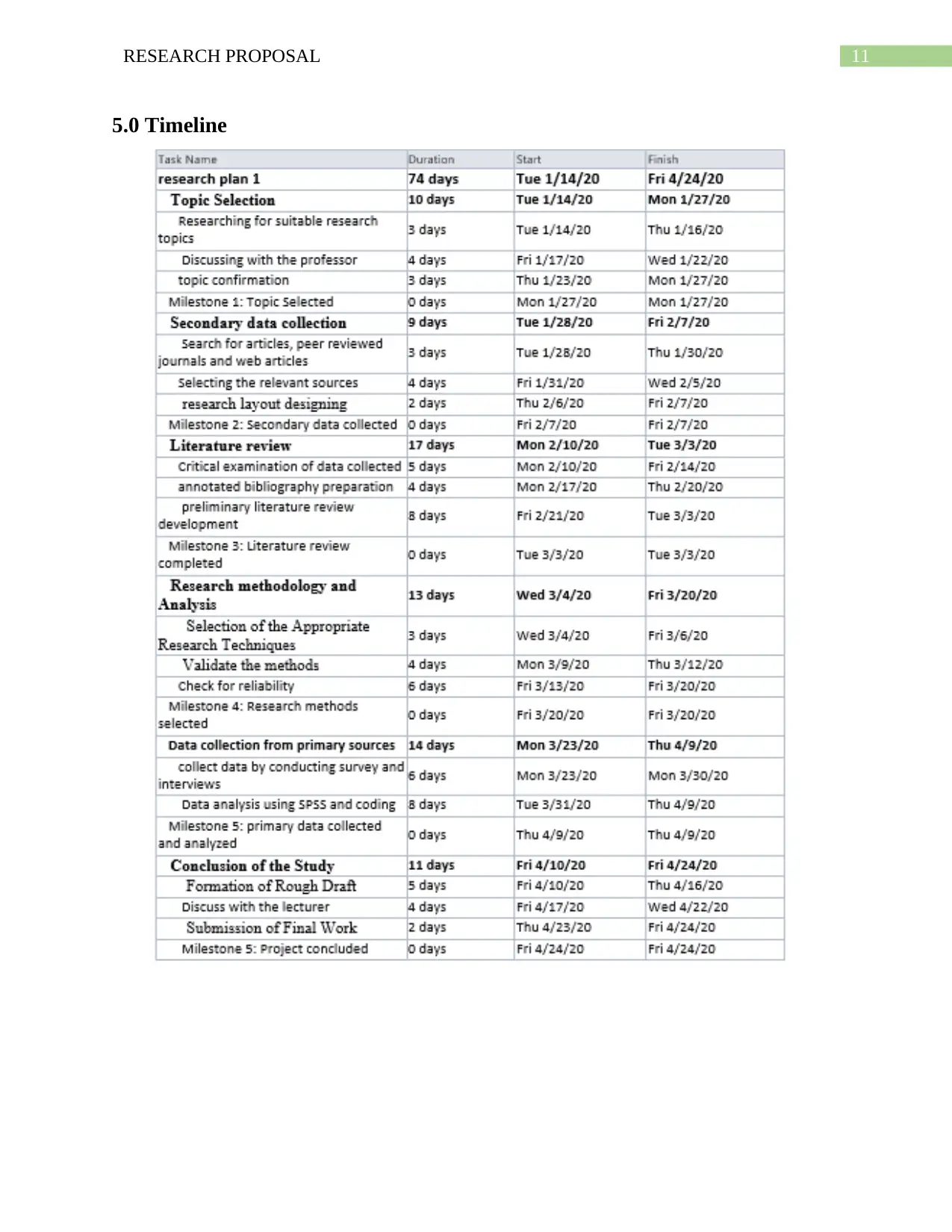
11RESEARCH PROPOSAL
5.0 Timeline
5.0 Timeline
⊘ This is a preview!⊘
Do you want full access?
Subscribe today to unlock all pages.

Trusted by 1+ million students worldwide
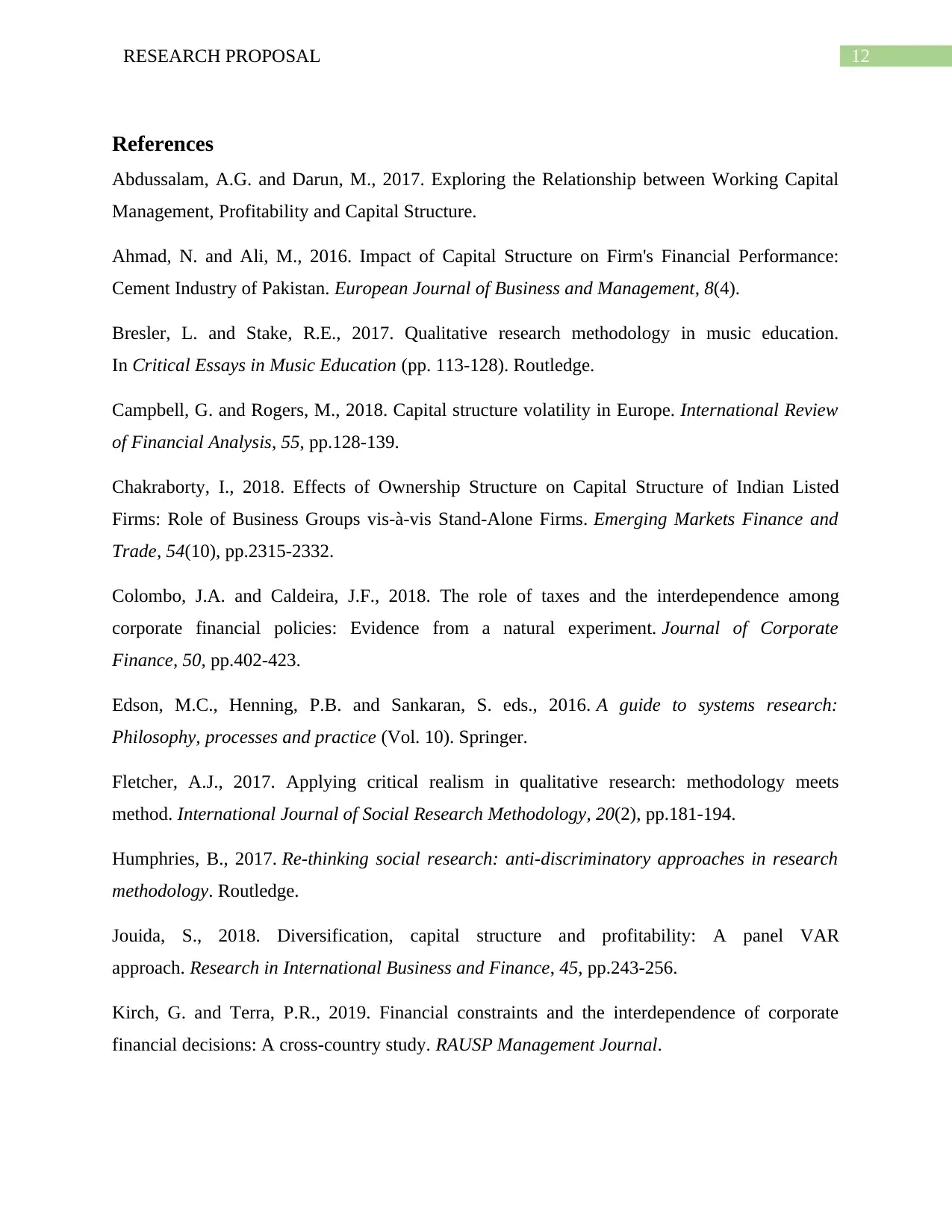
12RESEARCH PROPOSAL
References
Abdussalam, A.G. and Darun, M., 2017. Exploring the Relationship between Working Capital
Management, Profitability and Capital Structure.
Ahmad, N. and Ali, M., 2016. Impact of Capital Structure on Firm's Financial Performance:
Cement Industry of Pakistan. European Journal of Business and Management, 8(4).
Bresler, L. and Stake, R.E., 2017. Qualitative research methodology in music education.
In Critical Essays in Music Education (pp. 113-128). Routledge.
Campbell, G. and Rogers, M., 2018. Capital structure volatility in Europe. International Review
of Financial Analysis, 55, pp.128-139.
Chakraborty, I., 2018. Effects of Ownership Structure on Capital Structure of Indian Listed
Firms: Role of Business Groups vis-à-vis Stand-Alone Firms. Emerging Markets Finance and
Trade, 54(10), pp.2315-2332.
Colombo, J.A. and Caldeira, J.F., 2018. The role of taxes and the interdependence among
corporate financial policies: Evidence from a natural experiment. Journal of Corporate
Finance, 50, pp.402-423.
Edson, M.C., Henning, P.B. and Sankaran, S. eds., 2016. A guide to systems research:
Philosophy, processes and practice (Vol. 10). Springer.
Fletcher, A.J., 2017. Applying critical realism in qualitative research: methodology meets
method. International Journal of Social Research Methodology, 20(2), pp.181-194.
Humphries, B., 2017. Re-thinking social research: anti-discriminatory approaches in research
methodology. Routledge.
Jouida, S., 2018. Diversification, capital structure and profitability: A panel VAR
approach. Research in International Business and Finance, 45, pp.243-256.
Kirch, G. and Terra, P.R., 2019. Financial constraints and the interdependence of corporate
financial decisions: A cross-country study. RAUSP Management Journal.
References
Abdussalam, A.G. and Darun, M., 2017. Exploring the Relationship between Working Capital
Management, Profitability and Capital Structure.
Ahmad, N. and Ali, M., 2016. Impact of Capital Structure on Firm's Financial Performance:
Cement Industry of Pakistan. European Journal of Business and Management, 8(4).
Bresler, L. and Stake, R.E., 2017. Qualitative research methodology in music education.
In Critical Essays in Music Education (pp. 113-128). Routledge.
Campbell, G. and Rogers, M., 2018. Capital structure volatility in Europe. International Review
of Financial Analysis, 55, pp.128-139.
Chakraborty, I., 2018. Effects of Ownership Structure on Capital Structure of Indian Listed
Firms: Role of Business Groups vis-à-vis Stand-Alone Firms. Emerging Markets Finance and
Trade, 54(10), pp.2315-2332.
Colombo, J.A. and Caldeira, J.F., 2018. The role of taxes and the interdependence among
corporate financial policies: Evidence from a natural experiment. Journal of Corporate
Finance, 50, pp.402-423.
Edson, M.C., Henning, P.B. and Sankaran, S. eds., 2016. A guide to systems research:
Philosophy, processes and practice (Vol. 10). Springer.
Fletcher, A.J., 2017. Applying critical realism in qualitative research: methodology meets
method. International Journal of Social Research Methodology, 20(2), pp.181-194.
Humphries, B., 2017. Re-thinking social research: anti-discriminatory approaches in research
methodology. Routledge.
Jouida, S., 2018. Diversification, capital structure and profitability: A panel VAR
approach. Research in International Business and Finance, 45, pp.243-256.
Kirch, G. and Terra, P.R., 2019. Financial constraints and the interdependence of corporate
financial decisions: A cross-country study. RAUSP Management Journal.
Paraphrase This Document
Need a fresh take? Get an instant paraphrase of this document with our AI Paraphraser
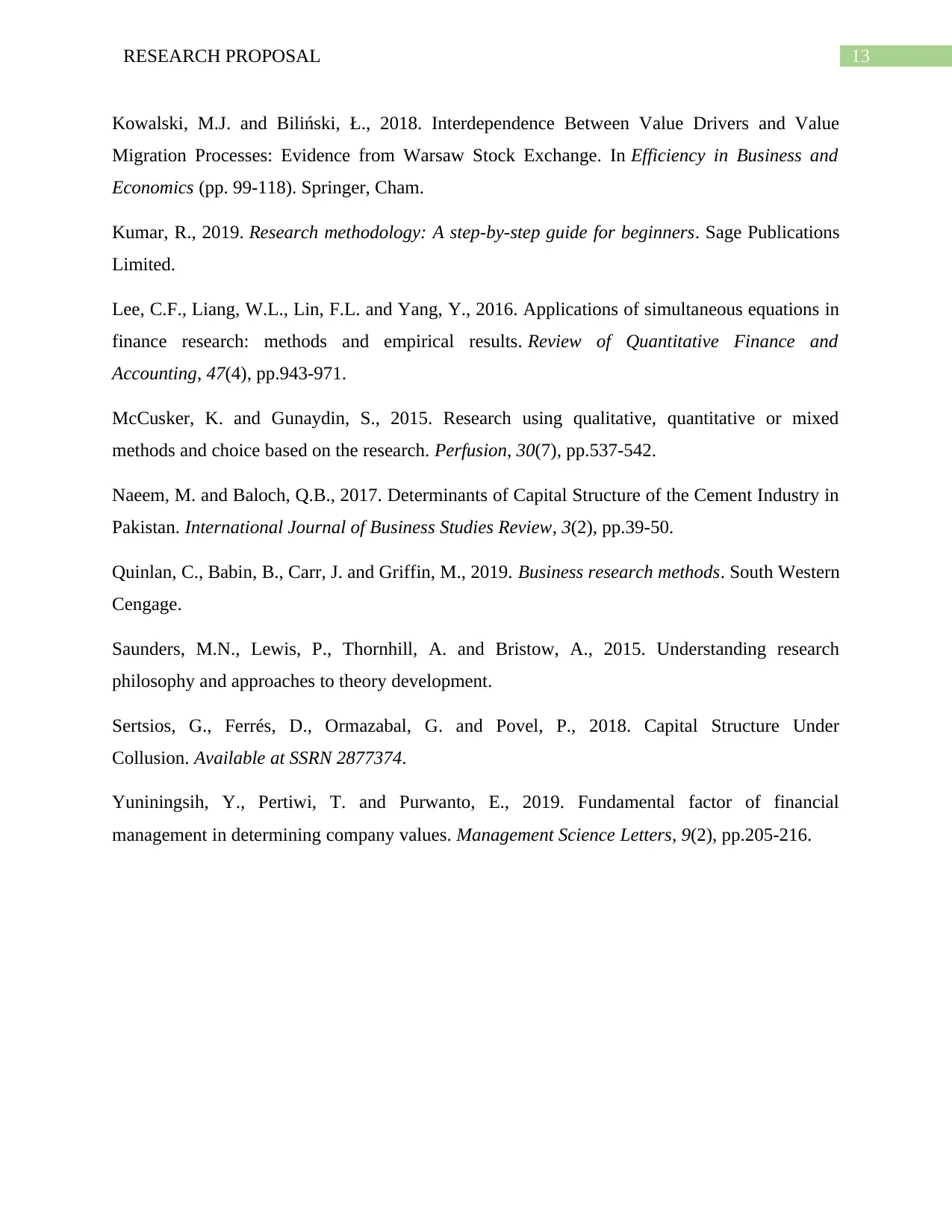
13RESEARCH PROPOSAL
Kowalski, M.J. and Biliński, Ł., 2018. Interdependence Between Value Drivers and Value
Migration Processes: Evidence from Warsaw Stock Exchange. In Efficiency in Business and
Economics (pp. 99-118). Springer, Cham.
Kumar, R., 2019. Research methodology: A step-by-step guide for beginners. Sage Publications
Limited.
Lee, C.F., Liang, W.L., Lin, F.L. and Yang, Y., 2016. Applications of simultaneous equations in
finance research: methods and empirical results. Review of Quantitative Finance and
Accounting, 47(4), pp.943-971.
McCusker, K. and Gunaydin, S., 2015. Research using qualitative, quantitative or mixed
methods and choice based on the research. Perfusion, 30(7), pp.537-542.
Naeem, M. and Baloch, Q.B., 2017. Determinants of Capital Structure of the Cement Industry in
Pakistan. International Journal of Business Studies Review, 3(2), pp.39-50.
Quinlan, C., Babin, B., Carr, J. and Griffin, M., 2019. Business research methods. South Western
Cengage.
Saunders, M.N., Lewis, P., Thornhill, A. and Bristow, A., 2015. Understanding research
philosophy and approaches to theory development.
Sertsios, G., Ferrés, D., Ormazabal, G. and Povel, P., 2018. Capital Structure Under
Collusion. Available at SSRN 2877374.
Yuniningsih, Y., Pertiwi, T. and Purwanto, E., 2019. Fundamental factor of financial
management in determining company values. Management Science Letters, 9(2), pp.205-216.
Kowalski, M.J. and Biliński, Ł., 2018. Interdependence Between Value Drivers and Value
Migration Processes: Evidence from Warsaw Stock Exchange. In Efficiency in Business and
Economics (pp. 99-118). Springer, Cham.
Kumar, R., 2019. Research methodology: A step-by-step guide for beginners. Sage Publications
Limited.
Lee, C.F., Liang, W.L., Lin, F.L. and Yang, Y., 2016. Applications of simultaneous equations in
finance research: methods and empirical results. Review of Quantitative Finance and
Accounting, 47(4), pp.943-971.
McCusker, K. and Gunaydin, S., 2015. Research using qualitative, quantitative or mixed
methods and choice based on the research. Perfusion, 30(7), pp.537-542.
Naeem, M. and Baloch, Q.B., 2017. Determinants of Capital Structure of the Cement Industry in
Pakistan. International Journal of Business Studies Review, 3(2), pp.39-50.
Quinlan, C., Babin, B., Carr, J. and Griffin, M., 2019. Business research methods. South Western
Cengage.
Saunders, M.N., Lewis, P., Thornhill, A. and Bristow, A., 2015. Understanding research
philosophy and approaches to theory development.
Sertsios, G., Ferrés, D., Ormazabal, G. and Povel, P., 2018. Capital Structure Under
Collusion. Available at SSRN 2877374.
Yuniningsih, Y., Pertiwi, T. and Purwanto, E., 2019. Fundamental factor of financial
management in determining company values. Management Science Letters, 9(2), pp.205-216.
1 out of 14
Related Documents
Your All-in-One AI-Powered Toolkit for Academic Success.
+13062052269
info@desklib.com
Available 24*7 on WhatsApp / Email
![[object Object]](/_next/static/media/star-bottom.7253800d.svg)
Unlock your academic potential
© 2024 | Zucol Services PVT LTD | All rights reserved.





